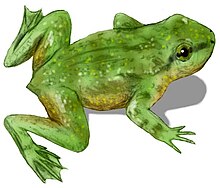Prosalirus
|
Prosalirus Temporal range: Early Jurassic |
|
|---|---|
 |
|
| Prosalirus bitis | |
| Scientific classification | |
| Kingdom: | Animalia |
| Phylum: | Chordata |
| Class: | Amphibia |
| Order: | Anura |
| Family: | †Prosaliridae |
| Genus: |
†Prosalirus Shubin & Jenkins, 1995 |
| Type species | |
|
Prosalirus bitis Shubin & Jenkins, 1995 |
|
Prosalirus bitis is the name given to a prehistoric frog found fossilized in Arizona in 1981 by Farish Jenkins. Geographica; "Jurassic Frog hops into the record book", National Geographic; August 1996, pg.5.
The skeleton has primitive features, but has mostly lost the salamander-like traits of its ancestors. It has a skeleton designed to absorb the force of jumping with its hind legs and tail. It also has long hip bones, long hind leg bones, and long ankle bones, all similar to modern frogs, and is as of 2009 the earliest such frog.
The name comes from the Latin verb prosalire, meaning 'to leap forward'. It is thought to have lived during the Early Jurassic epoch 190 million years ago, well before the first known modern frog, Callobatrachus.
As of 2009, only three Prosalirus skeletons have been discovered.
...
Wikipedia
